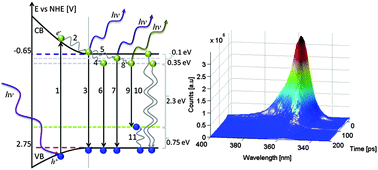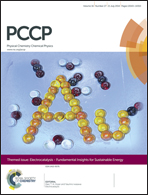A size dependent discontinuous decay rate for the exciton emission in ZnO quantum dots†
Abstract
The time resolved UV-fluorescence in ZnO quantum dots has been investigated using femtosecond laser spectroscopy. The measurements were performed as a function of particle size for particles between 3 and 7 nm in diameter, which are in the quantum confined regime. A red shift in the fluorescence maximum is seen while increasing the particle size, which correlates with the shift in band gap due to quantum confinement. The energy difference between the UV-fluorescence and the band gap does, however, increase for the smaller particles. For 3.7 nm particles the fluorescence energy is 100 meV smaller than the band gap energy, whereas it is only 20 meV smaller for the largest particles. This indicates a stabilization of the excitons in the smallest particles. The lifetime of the UV fluorescence is in the picosecond time scale and interestingly, it is discontinuous with respect to particle size. For the smallest particles, the exciton emission life time reaches 30 ps, which is three times longer than that for the largest particles. This demonstrates a transition between two different mechanisms for the UV-fluorescence. We suggest that this is an effect of surface trapping and stabilization of the excitons occurring in the smallest particles but not in the larger ones. We also discuss the time scale limit for slowed hot carrier dynamics in ensembles of quantum confined ZnO particles.


 Please wait while we load your content...
Please wait while we load your content...